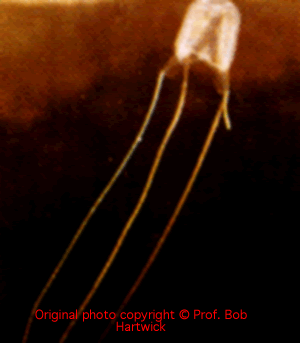 This important response to stings by several probably related
species of small and virtually invisible, tropical jellyfish (including
Carukia barnesii) is typified by mild local pain, usually without
skin marks. About 30 to 40 minutes later there may develop the typical
syndrome of cramping muscle, back and abdominal pains, prostration, hypertension
and occasionally, pulmonary or cardiac complications, notably pulmonary
oedema. This is a most unpleasant condition and is potentially lethal.
There is no antivenom. Hospitalisation is essential for the full blown
syndrome. Early vinegar application is recommended for nematocyst inhibition.
This important response to stings by several probably related
species of small and virtually invisible, tropical jellyfish (including
Carukia barnesii) is typified by mild local pain, usually without
skin marks. About 30 to 40 minutes later there may develop the typical
syndrome of cramping muscle, back and abdominal pains, prostration, hypertension
and occasionally, pulmonary or cardiac complications, notably pulmonary
oedema. This is a most unpleasant condition and is potentially lethal.
There is no antivenom. Hospitalisation is essential for the full blown
syndrome. Early vinegar application is recommended for nematocyst inhibition.
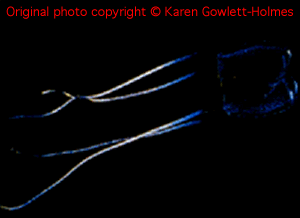 A small 4 tentacled box jellyfish found commonly (but not
exclusively) in southern Australian waters in summer, often in swarms.
The sting is painful, with an angry red mark. Significant systemic effects
are recently being reported from tropical waters.
A small 4 tentacled box jellyfish found commonly (but not
exclusively) in southern Australian waters in summer, often in swarms.
The sting is painful, with an angry red mark. Significant systemic effects
are recently being reported from tropical waters.
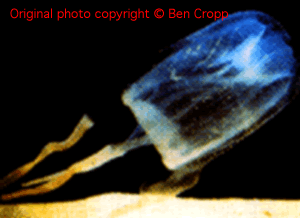 A large 4 tentacled box jellyfish from tropical waters, which
causes a very painful sting which may show cross hatching skin marks (as
seen with Chironex fleckeri). Systemic envenoming may occur, including
collapse, but there are no recorded deaths. There is no antivenom and
vinegar is effective as first aid.
A large 4 tentacled box jellyfish from tropical waters, which
causes a very painful sting which may show cross hatching skin marks (as
seen with Chironex fleckeri). Systemic envenoming may occur, including
collapse, but there are no recorded deaths. There is no antivenom and
vinegar is effective as first aid.
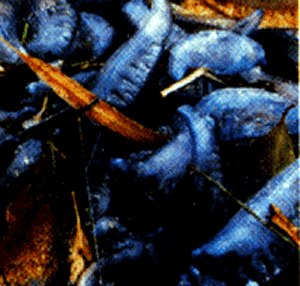 A medium sized "jellyfish" causing stings in northern and
eastern Australian waters mainly, often in swarms. There is immediate
pain lasting an hour or more, with typical elliptical blanched wheals
and surrounding erythema. Mild or no systemic symptoms are usual, but
a muscle-pain syndrome may occur. There is no antivenom. Vinegar or water
discharges adherent nematocysts.
A medium sized "jellyfish" causing stings in northern and
eastern Australian waters mainly, often in swarms. There is immediate
pain lasting an hour or more, with typical elliptical blanched wheals
and surrounding erythema. Mild or no systemic symptoms are usual, but
a muscle-pain syndrome may occur. There is no antivenom. Vinegar or water
discharges adherent nematocysts.
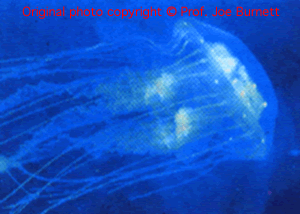 Moderate sized jellyfish which causes mild to moderate local
pain, lasting up to several hours. Allergic reactions can occur. There
is no antivenom and there is currently no substance which appears useful
in first aid to inactivate nematocysts. Vinegar is not effective.
Moderate sized jellyfish which causes mild to moderate local
pain, lasting up to several hours. Allergic reactions can occur. There
is no antivenom and there is currently no substance which appears useful
in first aid to inactivate nematocysts. Vinegar is not effective.
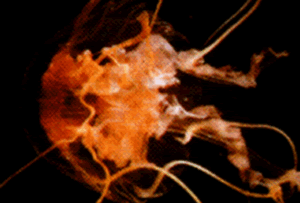 Large jellyfish, sometimes found in swarms, causing painful
stings with wheals, pruritis and swelling. Appears to have allergenic
venom. There is no antivenom.
Large jellyfish, sometimes found in swarms, causing painful
stings with wheals, pruritis and swelling. Appears to have allergenic
venom. There is no antivenom.
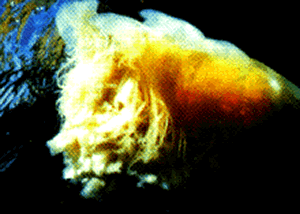 Very large jellyfish, causing moderate pain and redness of
short duration, without systemic envenoming. There is no antivenom, vinegar
is ineffective as first aid and should not be used.
Very large jellyfish, causing moderate pain and redness of
short duration, without systemic envenoming. There is no antivenom, vinegar
is ineffective as first aid and should not be used.
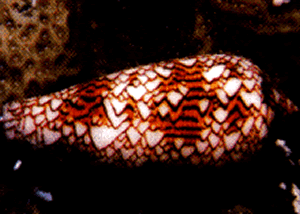 Only a few cone shells, from tropical waters, are known to
be hazardous to humans. Their venom contains a complex mixture of varied
toxins, noteably the conotoxins. The envenoming occurs usually when the
shell is picked up, and may result in local pain, potentially followed
by systemic envenoming, with progressive paralysis and collapse requiring
respiratory support. There is no antivenom.
Only a few cone shells, from tropical waters, are known to
be hazardous to humans. Their venom contains a complex mixture of varied
toxins, noteably the conotoxins. The envenoming occurs usually when the
shell is picked up, and may result in local pain, potentially followed
by systemic envenoming, with progressive paralysis and collapse requiring
respiratory support. There is no antivenom.
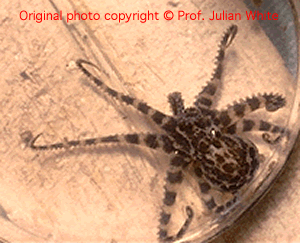 There are two species, found in all Australian coastal waters,
often commonly. These are small octopuses which, when alarmed, develop
vivid blue to purple rings on the body and tentacles. The saliva contains
a potent neurotoxin, tetrodotoxin. Bites virtually never occur unless
the octopus is removed from the water and placed on exposed skin. The
bite may not be painful. Not every bite results in systemic envenoming,
but paralysis, including respiratory paralysis, may develop quickly in
severe cases, requiring urgent respiratory support on the beach. More
often, the envenoming is less severe, with tingling around the mouth and
mild weakness. There is no antivenom.
There are two species, found in all Australian coastal waters,
often commonly. These are small octopuses which, when alarmed, develop
vivid blue to purple rings on the body and tentacles. The saliva contains
a potent neurotoxin, tetrodotoxin. Bites virtually never occur unless
the octopus is removed from the water and placed on exposed skin. The
bite may not be painful. Not every bite results in systemic envenoming,
but paralysis, including respiratory paralysis, may develop quickly in
severe cases, requiring urgent respiratory support on the beach. More
often, the envenoming is less severe, with tingling around the mouth and
mild weakness. There is no antivenom.
Stingray injuries mostly occur when a person steps on the ray, either when climbing out of a boat in shallow sandy water or when running into such water. The stingray whips its poison barbed tail around, lacerating the foot or lower leg, sometimes leaving a portion of the barb behind. The mechanical injury can be severe, with fatal cases due to direct heart or bowel puncture or transection of major limb vessels. Nerve or tendon damage can occur. The venom causes intense local pain, which is heat susceptible, hence the value of hot water immersion as first aid. Always check the wound for foreign bodies, allow to close by secondary intention and consider prophylactic antibiotics. The severe local pain may require major analgesia or regional nerve block. There is no antivenom.
Many fish have venomous spines, which can cause severe local pain and occasionally, as in the case of stonefish, possible systemic symptoms. Hot water immersion, medical analgesia, removal of residual spine(s) and consideration of prophylactic antibiotics and tetanus immunisation are the mainstays of treatment. There is an antivenom for stonefish stings.
There are a number of toxins found in fish, some of which are potentially lethal. The best known is tetrodotoxin (Fugu poisoning) found in pufferfish and some related species. Eating these fish may result in classic neurotoxic poisoning, as seen with blue ringed octopus bites. Removal of fish from the stomach and cardiorespiratory support are the main modes of treatment in severe cases.
Ciguatera is the other common and well known fish toxin, probably produced by micro-organisms (dinoflagellates) and concentrated via the food chain, so that people eating large fish may be poisoned. The toxic fish appear and taste normal, the first indication of problems being the development of "food poisoning", with vomiting and diarrhoea, but also muscle cramps, joint pain and parasthesiae. In severe cases there may be prostration and these patients usually feel miserable and very weak. There is no antivenom and treatment is controversial. Support with iv fluids is usually helpful and there is some clinical support for the early use of iv mannitol, which appears to greatly moderate symptoms in severe cases.
There are many species of sea snakes in northern Australian waters, though bites are uncommon, as these purely aquatic snakes are generally inoffensive. They are front fanged and have potent venoms acting systemically. Both paralysis and severe myolysis with secondary renal failure may occur, depending on the species of snake involved. More details are given under the section on CSL sea snake antivenom.Coagulopathy is not observed.